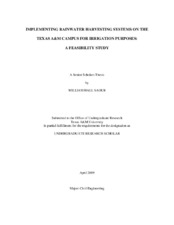| dc.description.abstract | Increasing population and increasing urbanization threatens both the health and availability of water resources. The volume and timing of water that is readily available may not be sufficient to supply the demand for potable water in urban areas. Rainwater harvesting is a water conservation strategy that may help alleviate water scarcity and protect the environment. The benefits of collecting rainwater and utilizing it as irrigation water are both tangible and non-tangible. Through collecting and reusing rainwater, grey water may be utilized as a practical resource. Although grey water is not safe to drink, it is safe for other uses such as toilet water, cleaning water, and irrigation. By utilizing rainwater harvesting, a facility saves the cost of purchasing potable water from the local water supply, and the local water supply is not as stressed. In addition, the volume of runoff that flows into local rivers will be reduced, and as a result, the erosion of river banks will be lessened, and ecosystem health may be sustained. The use of rainwater harvesting contributes to the sustainability of building design, calculated using LEED points. This study investigates the water conservation, economic, LEED design, and stormwater benefits of rainwater harvesting for the Texas A&M Campus. With tangible and non-tangible benefits, rainwater harvesting should prove to be a viable and appropriate solution to the conserving and sustaining of natural resources on Texas A&M University’s campus. | en |


